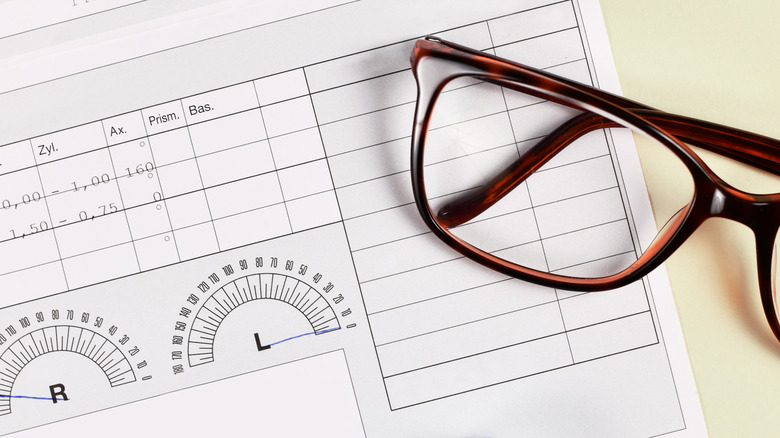How To Read An Eyeglass Prescription
If you're having vision problems, your eye doctor will likely prescribe corrective eyewear. However, from abbreviations to symbols, reading an eyeglass prescription can be tough and confusing. According to WebMD, an eyeglass prescription is broken down into two main categories, but sometimes three: OD, or oculus dextrus, meaning "right eye"; OS, or oculus sinister, meaning "left eye"; and occasionally OU, or oculus uterque, meaning "both eyes." All the abbreviations come from Latin terms.
Each eye is then divided into separate categories on an eyeglass prescription: SPH (sphere), CYL (cylinder), Axis, Add, and Prism. According to the American Academy of Ophthalmology, or AAO, SPH is the power of the lens needed to correct your vision, and often includes a plus or minus sign. A minus sign indicates you are nearsighted, meaning you see fine up close but not far away. A plus sign means you see better far away than up close. The further the number is away from zero, whether plus or minus, is an indication of a stronger eyeglass prescription.
CYL tells you if you have astigmatism, a common eye condition in which the eye is curved imperfectly. Typically, the eye is shaped like a basketball, but those with astigmatism may have an eye shape similar to an oval or egg (via AAO). With a round eye, the curve of the eye always stays the same, while the curve on eyes with astigmatism may be uneven.
Other eyeglass prescription categories
In addition to SPH and CYL, you may see Axis, Add, Prism, and Base on your eyeglass prescription. The Axis category contains degrees from one to 180, which tells you where an astigmatism is located on the cornea, Healthline reports. Add refers to the added magnifying power for the bottom part of multifocal lenses.
Prism, while not common, is when your doctor believes compensation for eye alignment is needed. This may be necessary for people with double vision issues. According to the AAO, prism helps turn two images into one. All About Vision reports that you may see one of four abbreviations to refer to the prism's direction. The directions include BD (Base Down), BU (Base Up), BI (Base In, toward the patient's nose), and BO (Base Out, toward the patient's ears).
If you have trouble understanding your eyeglass prescription, feel free to reach out to your eye doctor to have them explain it to you.


